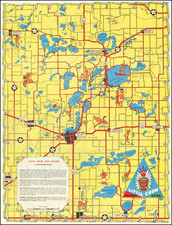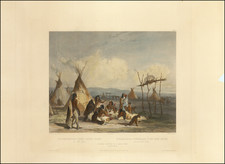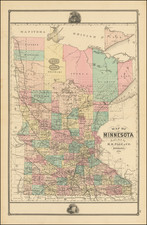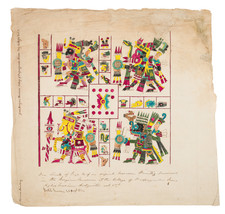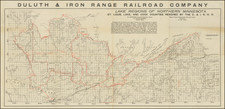The Most Famous Photograph of One of the Dakota Chiefs Hanged at Mankato.
Famous portrait of Marpiya Okinajin, or 'He Who Stands in the Cloud's, better known as Cut-Nose, before he was executed at Mankato for crimes committed during the Dakota Uprising of 1862.
Cut-Nose became infamous in the aftermath of the Uprising for his role in attacking white settlers in the Minnesota River Valley. As noted on the CDV, he was alleged to have killed 18 women and children and 5 men.
Heard, writing in the History of the Great Sioux Uprising and Massacre described Cut-Nose thusly:
The most repulsive-looking prisoner was Cut-nose, some of whose acts have been detailed by Samuel Brown. He was the foremost man in many of the massacres. The first and second days of the outbreak he devoted his attention particularly to the Beaver Creek settlement, and to the fugitives on that side of the river. I will give a single additional instance of the atrocity of this wretch and his companions. A party of settlers were gathered together for flight when the savages approached; the defenseless, helpless women and children, huddled together in the wagons, bending down their heads, and drawing over them still closer their shawls. Cut-nose, while two others held the horses, leaped into a wagon that contained eleven, mostly children, and deliberately, in cold blood, tomahawked them all---cleft open the head of each, while the others, stupefied with horror, powerless with fright, as they heard the heavy dull blows crash and tear through flesh and bones, awaited their turn. Taking an infant from its mother's arms, before her eyes, with a bolt from one of the wagons they riveted it through its body to the fence and left it there to die, writhing in agony. After holding for a while the mother before this agonizing spectacle, they chopped off her arms and legs, and left her to bleed to death. Thus they butchered twenty-five within a quarter of an acre. Kicking the bodies out of the wagons, they filled them with plunder from the burning houses, and, sending them back, pushed on for other adventures.
The National Portrait Gallery, London, relates the following biography of Cut-Nose:
Marpiya Okinajin, or 'He Who Stands in the Cloud's, was better known as Cut-Nose. He and and his band surrounded fleeing white settlers near Fort Ridgely, but were stopped from killing them by a Sisseton Dakota woman who had married a white Indian agent. After the Dakota conflict, Cut-Nose and 37 other Indians were hanged in Mankato on 26 December 1862, the largest 1 day execution in U.S. history. The bodies were dumped in a mass grave but a number of the other bodies were dug up the next day. Dr William Mayo, founder of Mayo Clinic in Rochester, dissected Cut-Nose's body and used the skeleton for anatomical research. 138 years later, his remains were ceremoniously buried, with all the honours due a chief.
James Edgar Martin (1825-1869), the owner of the studio, was born in Glenwell Falls, New York. He worked in Minnesota during the 1850s and 1860s. Initially, he established the Excelsior Photographic Gallery, which he sold to Alfred J. Hassler in 1864. Subsequently, he founded Martin's Art Gallery, specializing in stereoviews while also offering photographs from notable artists such as Benjamin F. Upton and Joel Emmons Whitney. In 1869, Martin sold the gallery to Joel Emmons Whitney, marking the end of his ownership.
Joel Emmons Whitney (1822-1886) was a multi-talented American artist known for his work as a Minnesota daguerreotypist, ambrotypist, photographer, lithographer, engraver, and publisher.
Whitney's career began under the tutelage of Alexander Hesler, the pioneer daguerreotypist of Galena, Illinois, in the summer of 1851. By November of that year, Whitney had opened his own establishment in St. Paul in the Gothic Building at the corner of Third and Cedar. Hesler returned to Minnesota in 1852, where the two again worked together, on a series of landscapes.
Charles A. Zimmerman went to work for Whitney around 1857 or '58; Zimmerman would go on to become Whitney's partner in the gallery.
Whitney was very active during the Civil War and the Dakota War of 1862, producing images of Minnesota volunteers and Sioux tribe members before and after the conflict in the Minnesota River Valley. Perhaps the most significant image he produced during this time was not his photograph but that of Adrian John Ebell. It is speculated that Ebell traded his famous "People escaping from the Indian massacre of 1862, at Dinner on a Prairie. Photographed by one of the party." to Whitney to settle a debt over photographic chemicals. Ebell had incurred that debt while on his way through St. Paul to western Minnesota. That image remains one of the most iconic photographs from the Plains Wars.
Later in life, Whitney built a sizable fortune investing in St. Paul real estate and businesses. He lost much of his money speculating in paper towns. He sold his interest in the gallery to Zimmerman on April 2, 1871, because of declining health. And moved to Atlanta that year, and Chattanooga in 1873. He returned to St. Paul in 1880, going into the grocery business, but again retiring for poor health. He died on January 20, 1886.











![Mexican Painting. 3776 Codex Vaticanus page 74. Aglio 3rd Vol. called the Little Vatican MS. [on sheet with] Quetzalcoatl Crucified Codex Borgianus...](https://storage.googleapis.com/raremaps/img/small/102318.jpg)
